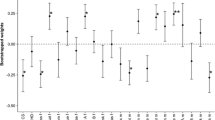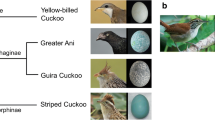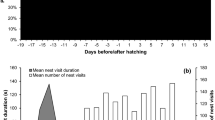Abstract
The outer layer of the eggshell in birds is in many cases covered by pigments that are assumed to be genetically determined traits with a negligible environmental component. To test the hypothesis that spring environmental conditions (i.e., temperature and rainfall) may affect bird egg pigmentation, we measured by spectrophotometry and photography egg coloration and spottiness on reed warbler (Acrocephalus scirpaceus L.) clutches parasitized by the common cuckoo (Cuculus canorus L.) collected over a period of 24 years and preserved in the Zoological Museum, Copenhagen, Denmark. In addition, we investigated whether spring environmental conditions may influence the coevolutionary relationship between the cuckoo and its host via changes in cuckoo–host egg matching. Generalized mixed models revealed that reed warbler eggs were more brilliant in those springs with a higher rainfall and tended to be bluer and greener in springs with a lower relative temperature. On the other hand, cuckoo eggs were bluer and greener in springs with a higher rainfall. Cuckoo–host egg matching in blue-greenness and spottiness was better in springs with a higher rainfall. These results provide support for the existence of an environmental component on bird egg coloration and suggest that environmental factors may potentially affect the outcome of important features of the arms race between cuckoos and reed warblers.





Similar content being viewed by others
References
Antonov A, Stokke BG, Moksnes A, Røskaft E (2006) Egg rejection in marsh warblers (Acrocephalus palustris) heavily parasitized by common cuckoos (Cuculus canorus). Auk 123:419–430
Avilés JM, Møller AP (2003) Meadow pipits (Anthus pratensis) egg appearance in cuckoo (Cuculus canorus) sympatric and allopatric populations. Biol J Linn Soc 79:543–549
Avilés JM, Møller AP (2004) How is host egg mimicry maintained in the cuckoo (Cuculus canorus)? Biol J Linn Soc 82:57–68
Avilés JM, Soler JJ, Soler M, Møller AP (2004) Egg appearance and rejection behaviour in magpies. Anim Behav 67:951–958
Avilés JM, Stokke BG, Moksnes A, Røskaft E, Møller AP (2006a) Nest predation and the evolution of egg appearance in passerine birds in Europe and North America. Evol Ecol Res 8:493–513
Avilés JM, Stokke BG, Moksnes A, Røskaft E, Åsmul M, Møller AP (2006b) Rapid increase in cuckoo egg matching in a recently parasitized reed warbler population. J Evol Biol 0:000–000
Avilés JM, Soler JJ, Pérez-Contreras T, Soler M, Møller AP (2006c) Ultraviolet colour vision of great spotted cuckoo eggs and egg rejection by magpies. Behav Ecol 17:310–314
Birkhead T (1978) Behavioural adaptations to high density nesting in the common guillemot Uria aalge. Anim Behav 26:321–331
Brooke MDL, Davies NB (1988) Egg mimicry by cuckoos Cuculus canorus in relation to discrimination by hosts. Nature 335:630–632
Cherry MI, Bennett ATD (2001) Egg colour matching in an African cuckoo, as revealed by ultraviolet–visible reflectance spectrophotometry. Proc R Soc Lond B 26:565–571
Collias EC (1984) Inheritance of egg-color polymorphism in the village weaver (Ploceus cucullatus). Auk 110:683–692
Cramp S (1998) Cramp’s the complete birds of the Western Palearctic. Optimedia. Oxford University Press, Oxford
Cuthill IC, Bennett ATD, Partridge JC, Maier EJ (1999) Plumage reflectance and the objective assessment of avian sexual dichromatism. Am Nat 153:183–200
Davies NB (2000) Cuckoos, cowbirds and other cheats. T & AD Poyser, London
Davies NB, Brooke MDL (1988) Cuckoos versus reed warblers: adaptations and counteradaptations. Anim Behav 36:262–284
Davies NB, Brooke MDL (1989) An experimental study of co-evolution between the cuckoo, Cuculus canorus, and its host. II. Host egg marking, chicks discrimination and general discussion. J Anim Ecol 58:225–236
Dunn PO, Winkler DW (1999) Climate change has affected breeding date of tree swallows throughout North America. Proc R Soc Lond B 266:2487–2490
Endler JA, Thery M (1996) Interacting effects of lek placement, display behavior, ambient light, and color patterns in three neotropical forest-dwelling birds. Am Nat 148:421–452
Gosler AG, Barnett PR, Reynolds SJ (2000) Inheritance and variation in eggshell patterning in the great tit Parus major. Proc R Soc Lond B 267:2469–2473
Gosler AG, Higham JP, Reynolds SJ (2005) Why are birds’ eggs speckled? Ecol Lett 8:1105–1113
Honza M, Procházka P, Stokke BG, Moksnes A, Røskaft E, Ĉapek Jr M, Mrlík V (2004) Are blackcaps current winners in the coevolutionary struggle against the common cuckoo? J Ethol 22:175–180
Hughes BO, Gilbert AB, Brown MF (1986) Categorisation and causes of abnormal eggshells: relationship with stress. Br Poult Sci 27:325–337
Jones J, Doran PJ, Holmes RT (2003) Climate and food synchronize regional forest bird abundances. Ecology 84:3024–3032
Joseph NS, Robinson NA, Renema RA, Robinson FE (1999) Shell quality and color variation in broiler breeder eggs. J Appl Poult Res 8:70–74
Karcza Z, Moskat C, Cherry MI, Kisbenedek T (2003) Experimental manipulation of intraclutch variation in the great reed warbler shows no effect on rejection of parasitic eggs. Ethology 109:15–22
Kaur H, Hughes MN, Green CJ, Naughton P, Foresti R, Motterlini R (2003) Interaction of bilirubin and biliverdin with reactive nitrogen species. FEBS Lett 543:113–119
Langmore NE, Hunt S, Kilner R (2003) Escalation of a coevolutionary arms race through host rejection of brood parasitic young. Nature 422:157–160
Lehikoinen E, Sparks TH, Zalakevicius M (2004) Arrival and departure dates. In: Møller AP, Fieldler W, Bethold P (eds) Birds and climate change. Elsevier, Leiden, pp 1–28
Lotem A, Nakamura H, Zahavi A (1992) Rejection of cuckoo eggs in relation to host age: a possible evolutionary equilibrium. Behav Ecol 3:128–132
McDonagh AF (2001) Turning green to gold. Nat Struct Biol 8:198–200
Moksnes A, Røskaft E (1995) Egg-morphs and host preference in the common cuckoo (Cuculus canorus): an analysis of cuckoo and host eggs from European museum collections. J Zool 236:625–648
Moreno J, Osorno JL (2003) Avian egg colour and sexual selection: does eggshell pigmentation reflect female condition and genetic quality? Ecol Lett 6:803–806
Moreno J, Morales J, Lobato E, Merino S, Tomás G, Martínez de la Puente J (2005) Evidence for the signaling function of egg color in the pied flycatcher Ficedula hypoleuca. Behav Ecol 16:931–937
Neuzil J, Stocker R (1993) Bilirubin attenuates radical-mediated damage to serum albumin. FEBS Lett 331:281–284
Øien IJ, Moksnes A, Røskaft E (1995) Evolution of variation in egg color and marking pattern in European passerines: adaptations in a coevolutionary arms-race with the cuckoo, Cuculus canorus. Behav Ecol 6:166–174
Payne RB (1973) Individual laying histories and the clutch size and number of eggs of parasitic cuckoos. Condor 75:414–438
Payne RB (1974) The evolution of clutch size and reproductive rates in parasitic cuckoos. Evolution 28:169–181
Polis GA, Hurd SD, Jackson CT, Pinero FS (1997) El Niño effects on the dynamics and control of an island ecosystem in the Gulf of California. Ecology 78:1884–1897
Punnett RC (1933) Inheritance of egg colour in the “parasitic” cuckoo. Nature 132:892–893
Punnett RC, Bailey PG (1920) Genetic studies in poultry. II. Inheritance of colour and broodiness. J Genet 10:277–292
Sillett TS, Holmes RT, Sherry TW (2000) Impacts of a global climate cycle on population dynamics of a migratory songbird. Science 288:2040–2042
Soler JJ, Møller AP (1996) A comparative analysis of the evolution of variation in appearance of eggs of European passerines in relation to brood parasitism. Behav Ecol 7:89–94
Soler JJ, Moreno J, Avilés JM, Møller AP (2005) Blue and green egg color intensity is associated with parental effort and mating system in passerines: support for the sexual selection hypothesis. Evolution 59:636–644
Soler M, Møller AP (1990) Duration of sympatry and coevolution between great spotted cuckoo and its magpie host. Nature 343:748–750
Solis JC, de Lope F (1995) Nest and egg crypsis in the ground nesting stone curlew Burhinus oedicnemus. J Avian Biol 26:135–138
Solomon SE, Bain MM, Cranstoun S, Mascimento V (1994) Hen’s eggshell structure and function. In: Board RG, Fuller R (eds) Microbiology of the Avian Egg. Chapman and Hall, London, pp 1–24
Stokke BG, Moksnes A, Røskaft E, Rudolfsen G, Honza M (1999) Rejection of artificial cuckoo (Cuculus canorus) eggs in relation to variation in egg appearance among reed warblers (Acrocephalus scirpaceus). Proc R Soc Lond B 266:1483–1488
Stokke BG, Moksnes A, Røskaft E (2002) Obligate brood parasites as selective agents for evolution of egg appearance in passerine birds. Evolution 56:199–205
Stokke BG, Rudolfsen G, Moksnes A, Røskaft E (2004) Rejection of conspecific eggs in Chaffinches: the effect of age and clutch characteristics. Ethology 110:459–470
Tinbergen N, Broekhuysen GJ, Feekes F, Houghton JC, Kruuk H, Szulc E (1962) Eggshell removal by the black-headed gull, Larus ridibundus L.: a behaviour component of camouflage. Behaviour 19:74–117
Torti VM, Dunn PO (2005) Variable effects of climate change on six species of North American birds. Oecologia 145:486–495
Underwood TJ, Sealy SG (2002) Adaptive significance of egg coloration. In: Deeming DC (eds) Avian Incubation. Oxford University Press, Oxford, pp 280–298
von Schantz T, Bensch S, Grahn M, Hasselquist D, Wittzell H (1999) Good genes, oxidative stress and condition-dependent sexual signals. Proc R Soc Lond B 266:1–12
Weidinger K (2001) Does egg colour affect predation rate on open passerine nests? Behav Ecol Sociobiol 49:456–464
Wyllie I (1981) The cuckoo. Batsford, London
Acknowledgements
We thank J. Fjeldså and J. Bolding of the ornithological section of the Zoological Museum of the University of Copenhagen for help and facilities during data collection. M. Åsmul photographed the clutches and J. J. Soler and I. C. Cuthill made very useful suggestions on a previous draft of the manuscript. M. Soler and two anonymous referees also made very useful suggestions on a previous draft of the manuscript. This research was funded by a European Community Postdoctoral Grant (MCFI-2000-00023) to J. M. A. and by the Research Council of Norway (grant no. 151641/432) to B. G. S. The Danish Meteorological Institute kindly provided access to weather data.
Author information
Authors and Affiliations
Corresponding author
Additional information
Communicated by M. Soler
Rights and permissions
About this article
Cite this article
Avilés, J.M., Stokke, B.G., Moksnes, A. et al. Environmental conditions influence egg color of reed warblers Acrocephalus scirpaceus and their parasite, the common cuckoo Cuculus canorus . Behav Ecol Sociobiol 61, 475–485 (2007). https://doi.org/10.1007/s00265-006-0275-0
Received:
Revised:
Accepted:
Published:
Issue Date:
DOI: https://doi.org/10.1007/s00265-006-0275-0




